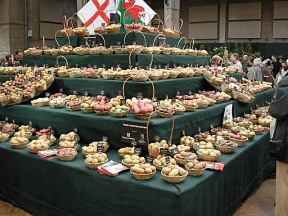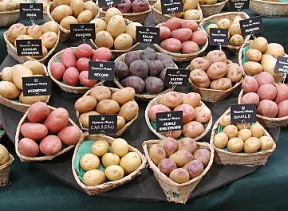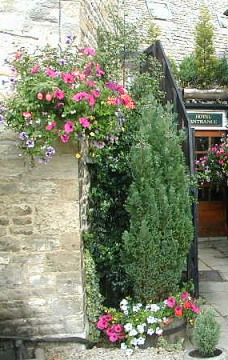Potatoesby Derek Burch
Call them pommes de terre, papas or spuds (where did that ugly slang word come from?), white, pink, russet, spotted, blue, black, any colour except green is fine for the skin of potatoes for the enthusiasts who are maintaining collections of old varieties.
|
And some of them really are old (the potato varieties that is), going back to unnamed local varieties from the Andes that may never have had a formal name until they were picked up by someone in another continent as a novelty. Actually that statement is probably completely misleading - the situation in the homelands of most of our cultivated crops is that each valley or each family will have identified their own distinct and prized variety which would have been passed on from generation to generation. Certainly the markets in the Andean regions are still a kaleidoscope of colors and forms for potatoes, all sold by name. Not many varieties have survived to the marketplace in Europe or North America, having been displaced by types that have a high yield and qualities such as shallow eyes and a less knobbly form that make them easier to prepare for the table. Nothing wrong with what we have either, certainly for my eating preferences, and I read an article recently that said that a high percentage of people in restaurants, when their meal includes potato in some form, will taste the potato before anything else. |
 |
 |
|
 |
|
 |
|
 |
The potatoes of many colours that are still found in the Andean markets would not transfer well to northern gardens (or indeed gardens in high latitudes of the southern hemisphere), because they have evolved under conditions where the days are short Their physiology is such that tuber formation is not triggered by the long days of northern summers, so they would give very small yields at best. The early importations into Europe and North America probably produced few tubers, but generated enough interest that they continued to be grown. There would then have been both conscious and unconscious selection of types that gave more tubers for future planting to the exclusion of those that produced fewer.
The commercial varieties are rather similar genetically, with the potential danger of this uniformity illustrated so disastrously at the time of the Irish famine, when the potato crops were destroyed by a fungus to which there was no inbred resistance. Many of our potatoes are still susceptible to this "late blight" to a greater or lesser degree, but the presence of resistance in the old Andean strains means that breeding work is now including these ancestral types to try to bring more resistance into our potatoes.
There is an 'International Potato Centre' in Peru that is coordinating the preservation of breeding stocks of potatoes (among many other programs designed to help alleviate world hunger). They brought together about 10,000 native cultivars, some of which could not be distinguished, but still left about 3,500 different strains that are being maintained and made available to breeders.
In the United States and Europe there are extensive collections at research centres, and in Great Britain more than 140 varieties are available to farmers and gardeners, although only a few are available commercially. We are even more limited in Florida, and rarely see more than half a dozen types in our stores.
My interest in potatoes
has been piqued recently by articles in 'The Garden ' - the excellent
magazine of the Royal Horticultural Society that I would hate to be without.
In October 2000, Jeremy Cherfas had an article entitled "Matter of
Taste' with great illustrations and a realistic critque of the eating
qualities of a number of coloured varieties. He refers to an earlier article
(August 1997) by Gordon Mackay that deals with the origins of the potato
in Peru and is the source of many of the numbers that I have mentioned
above. The real impetus for this article of mine, though, slow as it was
in its gestation, was the RHS show in London in October/November 2000
when "Three Counties Potatoes" - a consortium of four enthusiasts
- put together a display of 525 varieties. Fantastic!
 |
This was the display ... |
| ... and this was how each one was presented. Some of the unusual types included are referred to as 'Maori' potatoes: brightly colored types from New Zealand that may have been taken there directly from South America by old whaler ships. |
 |
The article on coloured forms by Jeremy Cherfas considers what happens to them in the kitchen. Some are coloured only on the surface, while others carry their colour all the way through, and stil others may have a ring or star of colour.The dark colours do not necessarily survive boiling, but stay bright with other methods of cooking. The texture as well as the taste is important, of course, and the relation of starchiness or waxiness to various cooking techniques is a whole distinct but fascinating subject. You can read about it in Little Potatoes, the website of a Canadian company that is very serious about what they grow. See them at http://www.littlepotatoes.com/html/varieties.html Their stuff makes my mouth water.
By the way, about green-skinned potatoes. Don't have anything to do with them! Light produces toxic materials in the skin of the tuber, and it means peeling them deeply to be sure of getting rid of it. Store potatoes in the dark, and enjoy them with the skins on.
Return to Table of Contents
